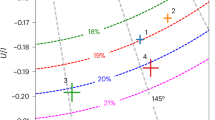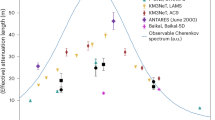Abstract
THE Crab Nebula may account for as much as 35% of the dispersion measure, D, of its pulsar, NP0532 (ref. 1). Davidson and Terzian1 have pointed out that if this is so, and if the ionised material is distributed uniformly over the volume of the nebula, then the Crab's expansion2 of ∼ 1,000 km s−1 should cause a decrease in D of about 0.07% per year. Isaacman and Rankin3 studied the dispersion measure over a 5-yr period, however, and observed no such decrease. From this, an upper limit to the Crab's contribution to D can be derived. It is much smaller than previously suspected.
This is a preview of subscription content, access via your institution
Access options
Subscribe to this journal
Receive 51 print issues and online access
$199.00 per year
only $3.90 per issue
Buy this article
- Purchase on SpringerLink
- Instant access to full article PDF
Prices may be subject to local taxes which are calculated during checkout
Similar content being viewed by others
References
Davidson, K. & Terzian, Y. Astronom. J. 74, 849–854 (1969).
Trimble, V. Astronom. J. 73, 535–547 (1968).
Isaacman, R. & Rankin, J. Astrophys. J. 214, 214–232 (1977).
Shklovskii, I. S. Supernovae (Wiley, London, 1968).
Trimble, V. & Woltjer, L. Astrophys. J. 163, L97–L98 (1971).
Baldwin, J. E. Proc. IAU Symposium 46, 22–31 (1970).
Spitzer, Jr, L. Diffuse Matter in Space 184 (Wiley, London, 1968).
Scargle, J. Astrophys. J. 156, 401–424 (1969).
Author information
Authors and Affiliations
Rights and permissions
About this article
Cite this article
ISAACMAN, R. NP0532 and a hole in the Crab Nebula. Nature 268, 317–318 (1977). https://doi.org/10.1038/268317a0
Received:
Accepted:
Issue date:
DOI: https://doi.org/10.1038/268317a0



